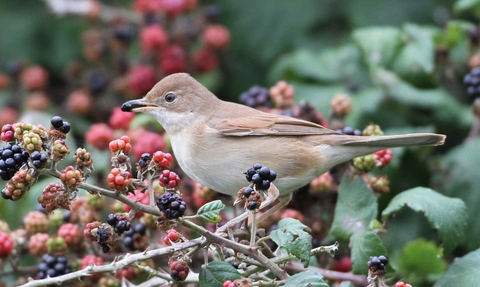
WildNet - Margaret Holland
Where to see nature's autumn larder
As winter approaches, autumn is the time for wildlife to feast and build up reserves to last the long cold winter. The hedgerows have a beautiful display of berries, hips and ripening nuts as the nectar and pollen rich flowers that provided in the spring now give again. The developing seeds have an outer fleshy coating, tasty and colourful to attract birds and mammals. Because the fruits ripen at slightly different times, there’s a succession of food over time. Nuts are particularly nutritious and often buried to eat later when food is scarce.
Birches Farm
There are hedgerows aplenty at Birches Farm, the fourteen fields on the reserve are all small and many of the hedgerows are centuries old. There’s creamy purple sloes on the blackthorn, red berries on the rowan and small red hips on the hawthorn.
This year is a good one for hazel nuts. Have a look in the leaf litter under a hazel tree for the shells, it’ll give you a clue as to who’s eaten the nut. Squirrels tend to split the nuts neatly in half, dormice leave a smooth, round hole in the side of the nut, with tooth marks running around the inside of the hole while wood mice leave tooth marks on the surface of the nut and across the edge of the hole. Great spotted woodpeckers break nuts into pieces or leave large, irregular holes.
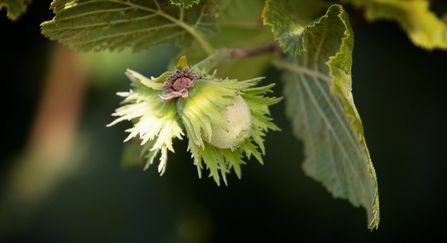
Hazel nut (c) Jon Hawkins – Surrey Hills Photography
Common Hill
Up on a ridge above Fownhope lies Common Hill and its hedgerows of oak, hazel, holly and dogwood with both white and black byrony growing vine-like among the hedgerow branches. The strings of bright red berries belonging to both bryony plants are easy to spot but beware, they are poisonous - but not to the birds who feast on them to no ill effect. Acorns from the oak trees provide winter food for many woodland creatures including mice, squirrels and birds including jays. Surprisingly, squirrels are able to find up to 95% of their buried food, using a combination of smell and excellent memory.

Jay with acorn (c) Margaret Holland
Brilley Green Dingle
This wooded dingle is delightful with a path following the Millhalf brook (can be muddy after rain) before climbing up the slope to higher ground. Here, you can find sweet chestnut, the shiny brown fruits, or 'chestnuts' are wrapped in a spiky, green casing. The tree hails from southern Europe and is thought to have been introduced to Britain by Roman legions as a source of food. The woodland understorey is dominated by hazel and holly, the hazelnuts providing autumn food for the dormice, yellow-necked mice and wood mice recorded here while holly berries attract blackbirds, redwings and thrushes.
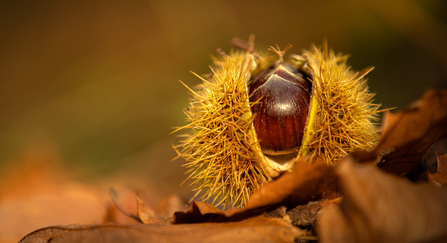
Sweet chestnut (c) Jon Hawkins – Surrey Hills Photography
Wessington Pasture
Not far from Common Hill but very different in nature, the woodland in the reserve is dense with some very large ancient hazel trees and understorey shrubs of spindle, blackthorn and sweet briar. The fragrant pink flowers of sweet briar turn into red globular fruit called hips. These rose hips are high in vitamin C and are harvested commercially for processing into Rose Hip syrups.
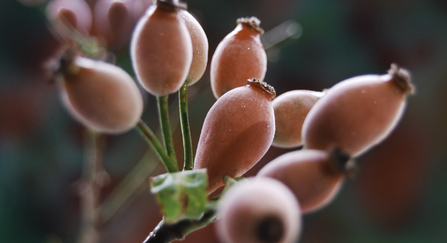
Rosehips (c) Alan Price
The Sturts
The three reserves that make up The Sturts have a mixture of centuries old hedgerows and ancient pollarded crack willow with ponds and meres that flood in the winter. Blackthorn, elm, hawthorn, field maple, hazel and the rather unusual spindle grow in the thick hedges. Spindle is easily identified by its red leaves and vivid pink fruits with bright orange seeds, which look a bit like popcorn. The fleshy seed coverings are high energy morsels particularly popular with robins, blackbirds and blackcaps. Overall, the hedges support a wide range of birds including migratory siskin and redwing while the fallen fruit in the orchard of The Sturts North is popular with fieldfares.
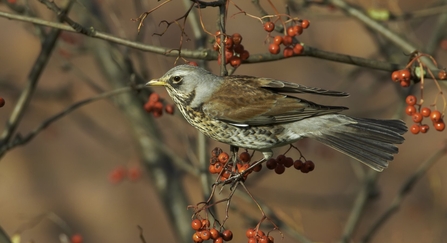
Fieldfare (Turdus pilaris), perched on branch with rowan berries (c) Richard Steel/2020VISION
